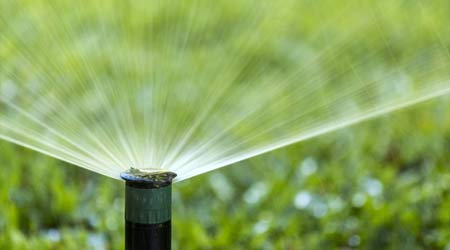Irrigation: Green Strategies and Technology Advances
Part one of a three-part article on new-generation irrigation technology
As water shortages worsen across the country, grounds managers with institutional and commercial facilities are taking a closer look at the state of their grounds irrigation systems. Specifically, they are looking for opportunities to minimize water waste and maximize system effectiveness and savings.
Among the tools at their disposal to achieve these goals are two technology advances and one important change in irrigation practices. By incorporating these elements into their irrigation management activities, managers can deliver benefits well into the future.
The newest generation of smart controllers for irrigation systems can connect to the internet, so system operators can access them anytime from anywhere. One important benefit of these controllers is that they do not need to be located near the main controller.
The controllers also allow users to operate systems more efficiently by setting specific programs or having pre-set programs run based on soil and weather conditions. For instance, controllers can account for such weather elements as wind, rain, temperature, and humidity, which keeps turf and other vegetation healthy and minimizes water use.
Smart controllers also have pre-set programs based on soil profiles, which allows the systems to monitor the rate at which water leaches and absorbs. As a result, the system will only water the grounds when the soil needs hydration.
Smart controllers also help facilities stay within watering guidelines in regions in which water use is restricted based on the time of day or an amount per week. Water-conservation initiatives have become so strict that some states now use water police and water courts to make sure residents and businesses comply with the regulations.
In 2015, California issued an executive order requiring cities to reduce water use by 25 percent within less than a year. Districts that miss the target could be fined $10,000 a day starting March 1, 2016, according to the state’s Water Resources Board. This development means many managers need to worry about more than the amount of their water bills if they do not implement new technology. They also will have to worry about fines. Luckily, drought-prone states, including California, Florida, and Texas, offer rebates on new technology that are designed to minimize the risk of a fine and make products more affordable and appealing.
While wireless controllers can be expensive, they are no more expensive than a digital controller, and managers will see an immediate return on the investment after purchase. Some manufacturers actually give their customers an assessment of the amount they can expect to save by using their controller systems.
Installing new-generation controllers takes the same level of expertise as installing the other kinds of controllers. But if managers are going to incorporate moisture sensors, they should consider outsourcing the task of installation, as it can be complex.
To accurately connect moisture sensors into irrigation systems, managers and their teams must understand the way the technology works and the most appropriate location. If workers install it too high or too low, it will be ineffective. Manufacturers can provide support by educating customers about the most effective use of the product, and they can recommend an installer.
Controllers have been around for more than a decade, but only recently have they attracted much attention, due to the recent green initiatives and increased drought problems. But even if a facility updated its irrigation system in the last five years, managers still should look into updating the system, since new controllers offer important advances and benefits.
Related Topics:















